Big Red Market
Project Overview
For the final project in my Design & Innovation course at Cornell University, AEM 3110 with Professor Denise Ramzy, I was tasked with developing a service or product to enhance the town of Ithaca. In collaboration with three other students, I created a mock-service designed to increase sustainability and community engagement through the exchange of second-hand goods within and between the Ithaca and Cornell communities. Big Red Market is a mobile app concept designed to streamline the exchange of goods within the town of Ithaca and on Cornell's campus.

Overview
The Problem
With a student population roughly two-thirds the size of the town of Ithaca's total population, Cornell University generates significant amounts of compost waste (over 6000 tons per year), landfill waste (over 3000 tons per year), and wastewater. This project aims to reduce waste production among Cornell students by promoting the sharing and reuse of household and dormitory supplies within the student community.
"How Might We" Question
How might we promote item reuse within the Cornell community to enhance sustainability efforts and reduce waste effectively?
Scope
This project specifically targets waste reduction efforts within Cornell University, with a focus on addressing household and dormitory waste originating from both on-campus and off-campus student housing.
My Role
I worked collaboratively with three students on this project, taking on a role that involved co-leading interviews and leading the UI design for Big Red Market by crafting paper and digital wireframes as well as developing high-fidelity prototypes. Additionally, I led the development of our research plan, provided support in conducting usability studies to validate our designs, and made sure to prioritize accessibility considerations throughout the process.
Understanding the User
Research Plan
Our focused on understanding the existing solutions and needs surrounding the circulation of second-hand items within the Cornell community. We also hoped to identify prospects for enhancing waste reduction and promoting sustainability on campus.
Stakeholders included Cornell students, Cornell administration, residence hall advisors, and landlords, with extreme users being students on tight budgets and those prioritizing sustainability, while non-users are individuals who refuse to buy or use second-hand items.
Data collection methods include surveys, stakeholder interviews, online platform observation, and studying analogous cases from other institutions. Our research will span student dorms, off-campus housing, Ithaca's reuse centers, and online platforms, offering a holistic view of Cornell's second-hand goods ecosystem.
Pain Points
From our research, we identified the following pain points common among Cornell students.
- There are no centralized platforms or dedicated online spaces for the buying and selling of second-hand goods among Cornell students. While Facebook groups exist, they are disorganized and inefficient.
- Many college students operate on a tight budget. The platform would offer them a way to buy items they need at a reduced cost and sell items they no longer use to earn extra money.
- Students may face difficulties in transporting items to their dorms or apartments, especially if they do not have access to a car. Stores like Target and Walmart are difficult to get to using public transportation.
- The timing of move-in and move-out dates may create a gap in the circulation of second-hand items, as students may not have enough time to buy or sell used items.
User Personas
Based on our research, we developed three user personas to help us guide and inform our designs for Big Red Market.
1. The Environmentally Aware Freshman
Taylor is an 18-year-old Cornell freshman who has made a personal commitment to keep her college experience as close to zero-waste as she can. She does not want to buy anything new if she can help it, and has high standards for the durability of the products she purchases.
| Goals | Challenges | Motivations | Needs |
|---|---|---|---|
| Find affordable, durable, second-hand dorm and household items Easily donate unwanted items at the end of the school year to prevent them from going to waste | Finding a convenient online platform for buying and selling second-hand items Frustrated with disorganized options like Facebook marketplace Shipping second-hand goods conflicts with her environmental principles | Reduce environmental impact through second-hand purchases Combat "disposable culture" on college campuses Keep items in circulation to reduce landfill waste Set an example for low-waste dorm living | Cornell-verified marketplace with walking distance filters In-app move-out donation scheduler with campus drop-off locations Trust signals like NetID verification and seller ratings |
2. The Cost-Conscious Student
Benjamin is a 19-year-old Cornell freshman from a low-income background. Most of his financial aid goes toward tuition and meal plans, so every non-essential purchase has to be justified. He needs an efficient way to furnish a small dorm room, stretch a limited budget, and later pass items on without hassle.
| Goals | Challenges | Motivations | Needs |
|---|---|---|---|
| Secure second-hand furniture, decorations, and supplies at the lowest total cost Off-load or donate items at year-end to avoid storage fees | Scattered listings across multiple platforms Off-campus sellers requiring paid delivery he can't afford Variable quality and seller reliability creating risk of wasted money | Every dollar saved can cover textbooks or emergencies Affordability is the primary driver Smooth donation path avoids summer storage costs | Cornell-verified marketplace with walking distance filters Up-front pricing and condition descriptions In-app reminders for move-out donations Trust signals to reduce scam risk |
3. The Convenience First CS Major
Lily is a 21-year-old Cornell junior majoring in Computer Science. Between upper-level coursework, an internship, and two student clubs, her calendar is packed. She cares about sustainability but only if the tools she uses respect her time and mental bandwidth.
| Goals | Challenges | Motivations | Needs |
|---|---|---|---|
| Furnish and refresh apartment setup with quality second-hand items Keep environmental footprint low without adding chores Off-load items quickly at semester transitions | Traditional resale channels demand time-consuming back-and-forth messaging Inconsistent listing quality makes quick decisions difficult Coordinating handoffs around busy schedule is a logistical headache | Efficiency: fewer taps and messages the better Maintain tidy living space that adapts to housing changes Contribute to campus sustainability without derailing schedule | Well-organized, Cornell-verified marketplace with strong search One-click payment and automated pickup scheduling Clear status tracking to eliminate follow-up messages Bulk-listing option for move-out with preset pickup windows |
Market Analysis
Existing Options in and around Cornell
| Service | How it Works | Strengths | Limitations |
|---|---|---|---|
| Cornell Thrift (Instagram) | Weekly "drops" posted to an Instagram feed. Buyers DM the account and pay with Venmo; pickup happens during a narrow on-campus window. | Free advertising channel and familiar social interface for students. | Clothing only. No search or filtering. Transactions disappear in DM threads, so there is no audit trail or ratings. Miss the pickup slot and the deal is gone. |
| Dump & Run Sale | Student-led collection at spring move-out, then a giant sale the last two August weekends. | Keeps tons of goods out of landfill in a single sweep. | One event per year means items sit idle all summer. $25 delivery fee discourages budget-minded students. Since 2021 the sale has been at the Ithaca Mall, far from most dorms. |
| Finger Lakes ReUse | Brick-and-mortar warehouses around Ithaca with everything from sofas to laptops. | Broad inventory, professional staff. | Off-campus locations require a car or long bus ride. No live online catalog, so students cannot browse before committing to the trip. Not integrated with Cornell ID, so it feels detached from campus life. |
Key Insights
- No unified digital hub
Every option above solves a slice of the reuse problem but none give students one place to browse, buy, sell, and donate everything from futons to physics textbooks. - Trust and safety gaps
Instagram DMs and anonymous marketplace posts make it hard to verify buyers or sellers. NetID-based sign-in and basic rating tools would raise confidence and cut scams. - Logistics are the bottleneck
Off-campus pickup fees, limited event windows, and car-dependent warehouses force students to choose new retail by default. A campus-centric handoff network (lockers, staffed drop spots, or peer couriers) would flip that convenience equation.
Starting the Design
Idea Frames:
We developed three potential solutions to Cornell's waste problem:
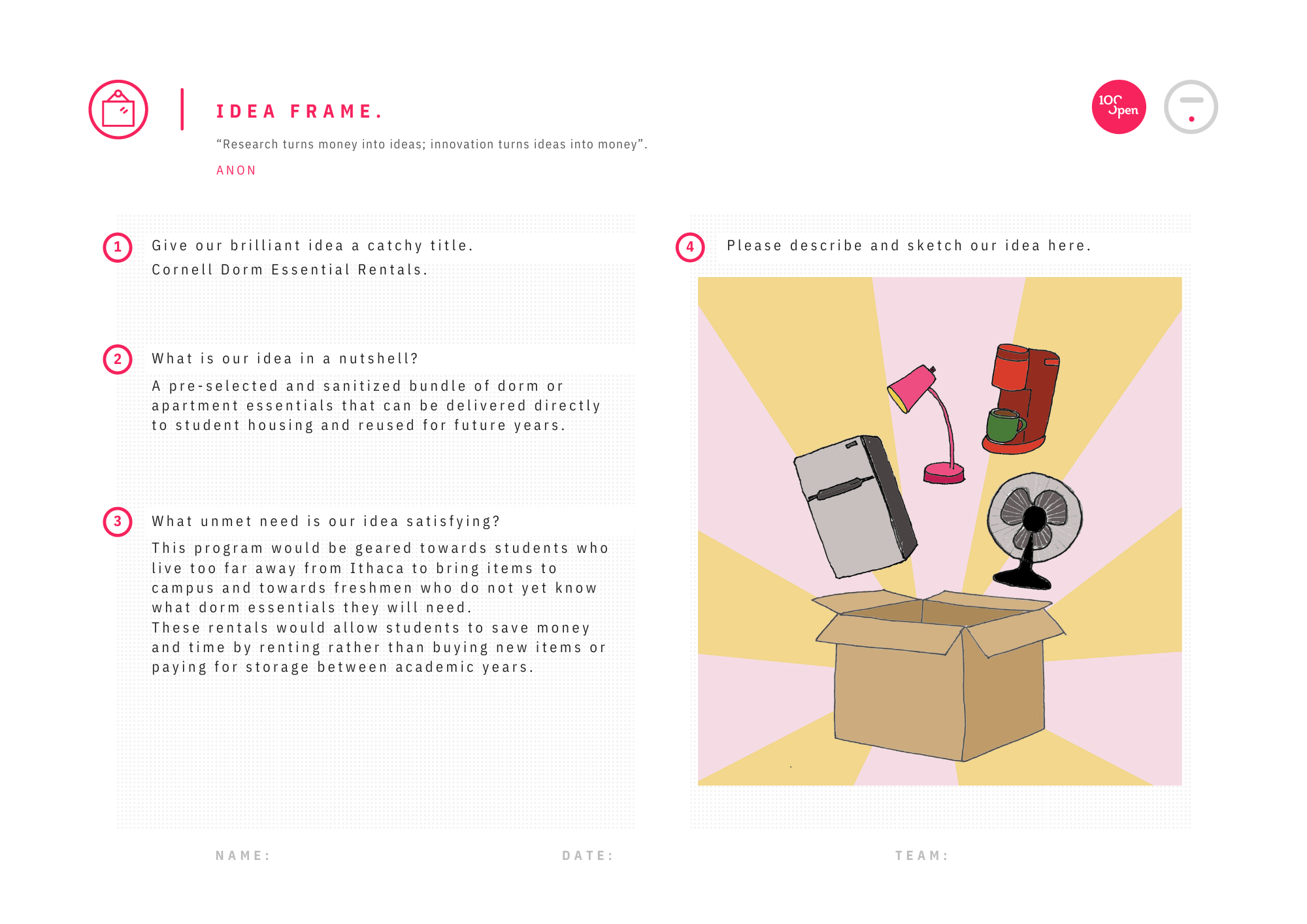
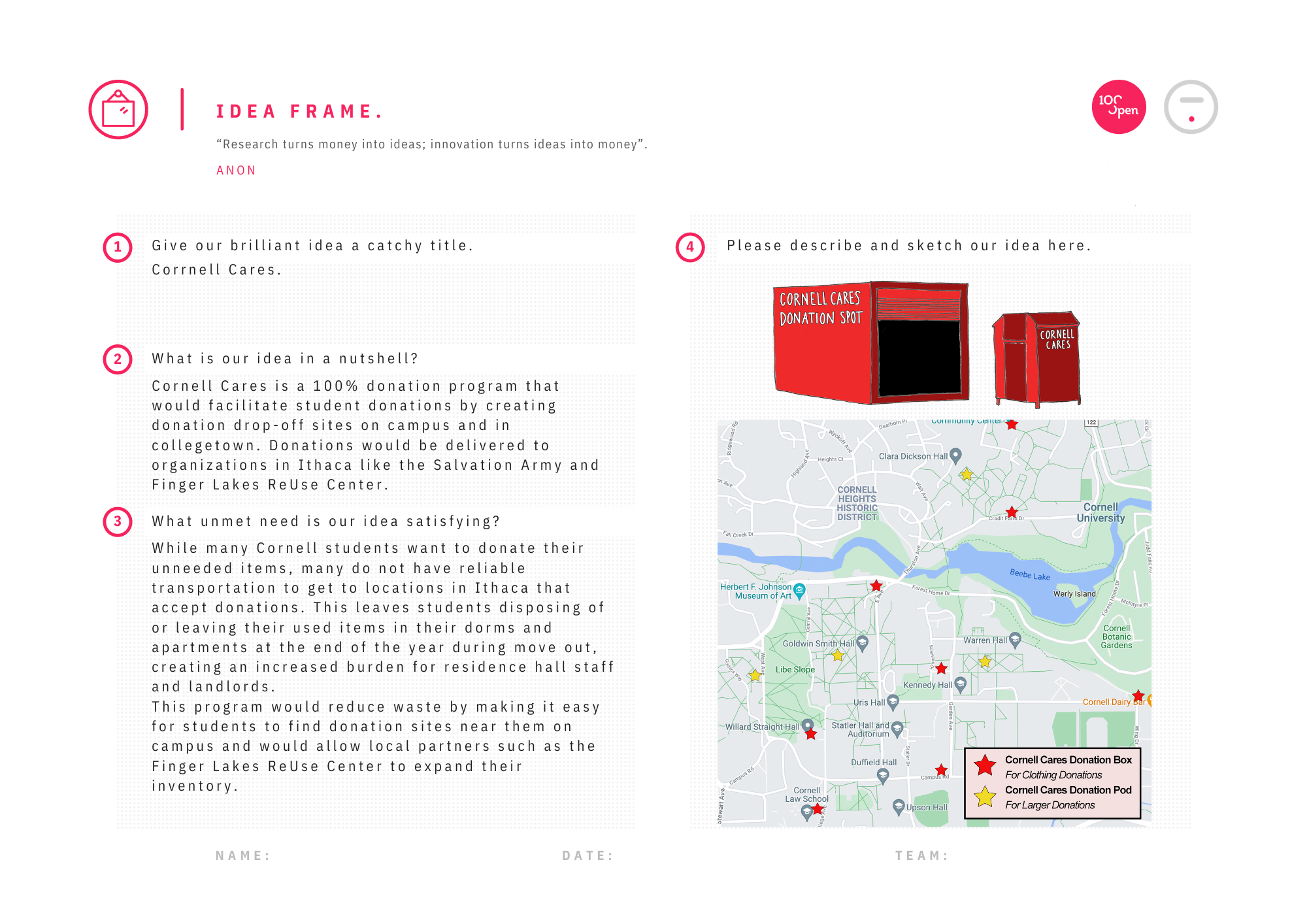
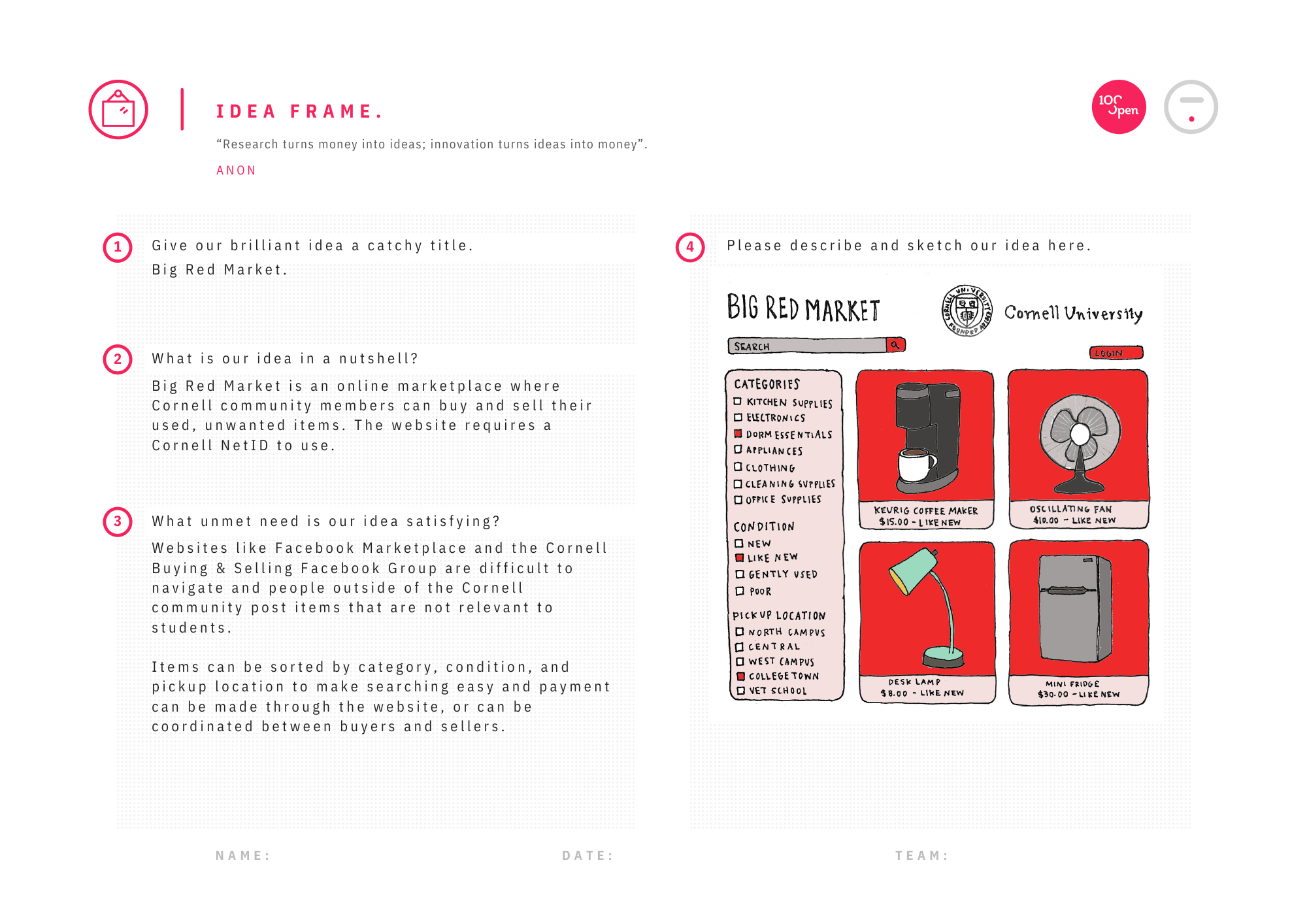
Initial Sketches & Planning
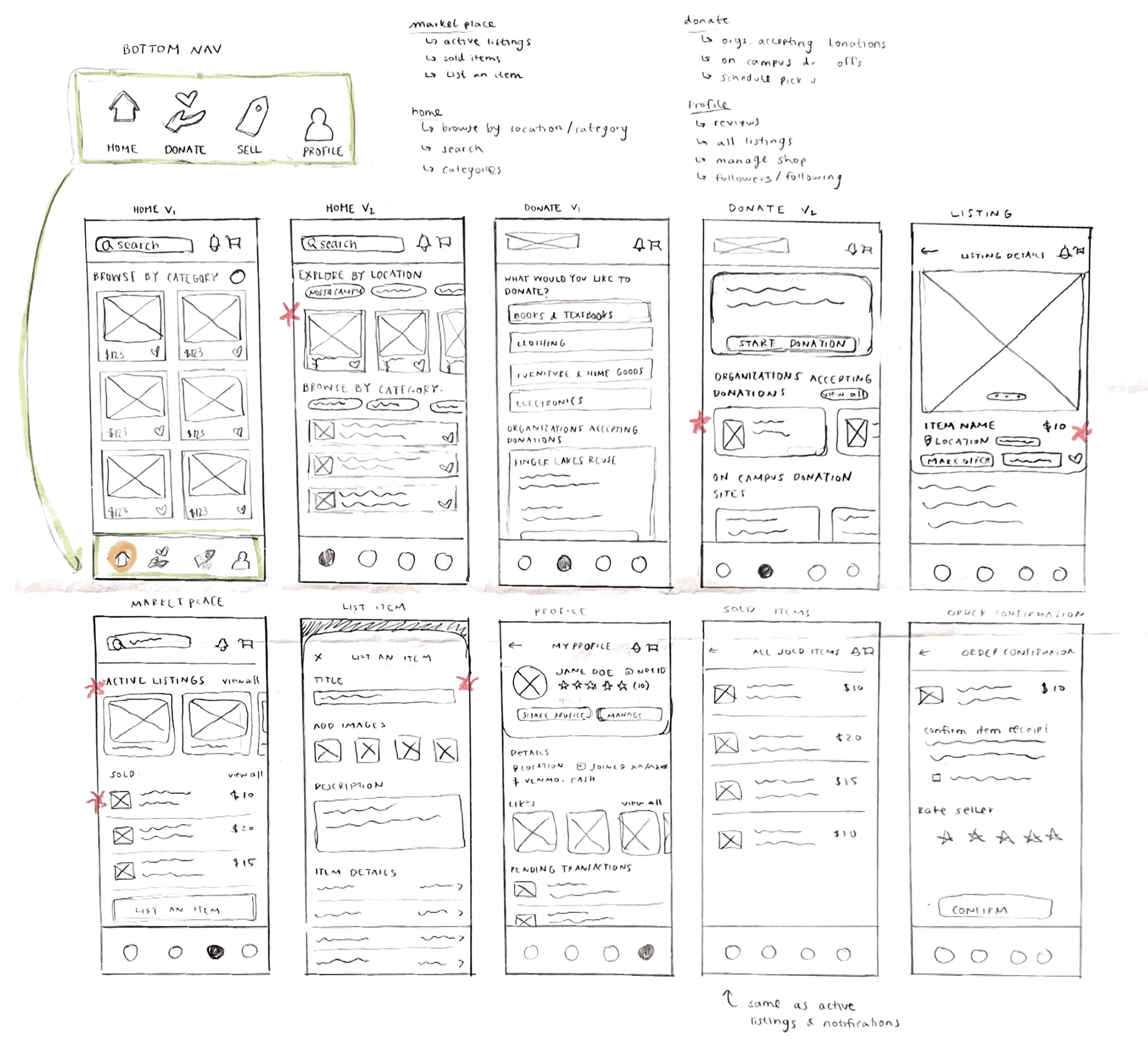
Digital Wireframes & Low Fidelity Prototype
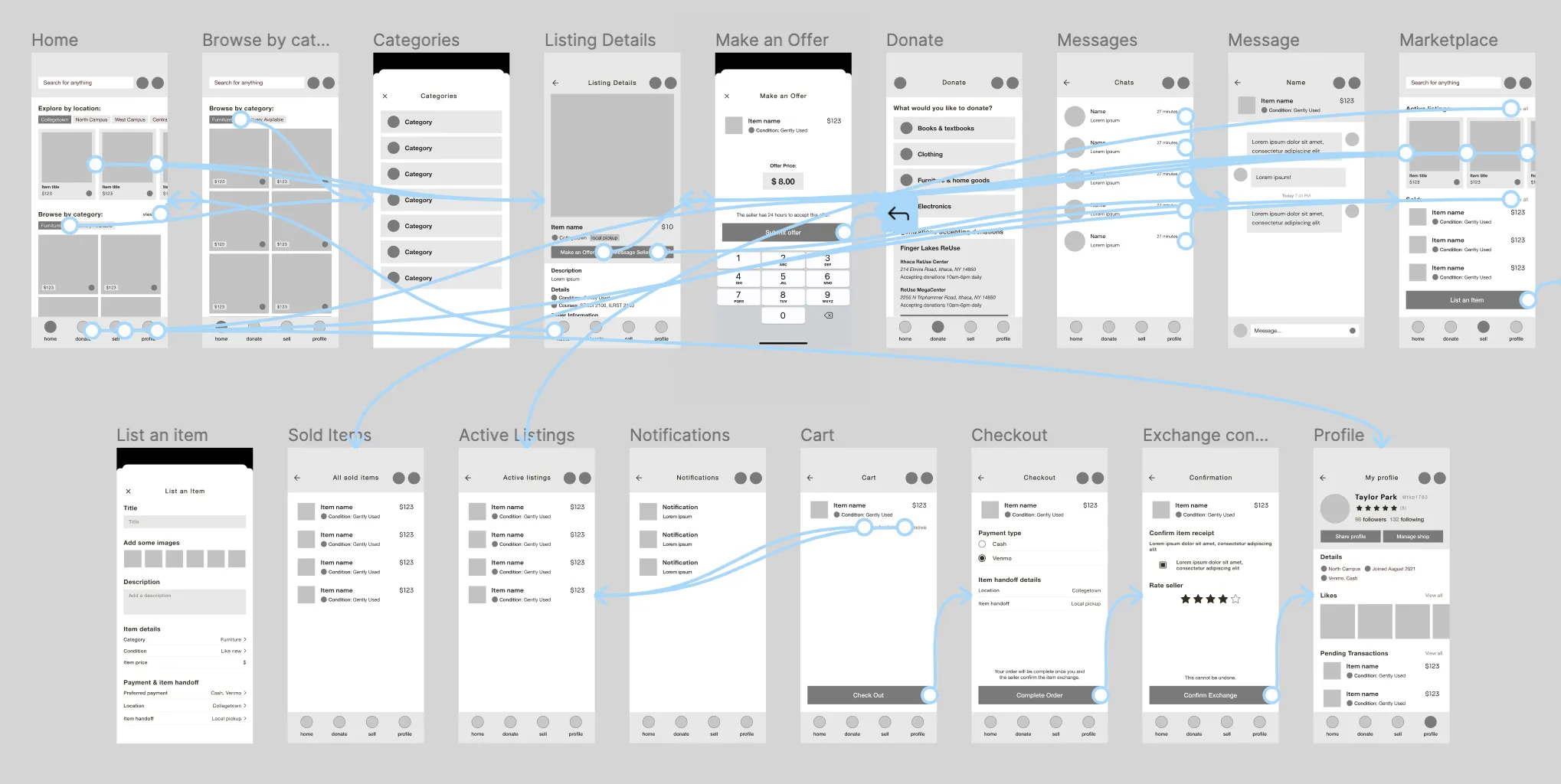
View the wireframes/low-fidelity prototype in Figma: Figma Low-Fidelity Prototype
Usability Study Findings
We conducted multiple usability studies, supplemented with A/B testing, throughout this project to ensure that our product met the needs and expectations of our users while continuously improving its user experience. These studies were a critical part of our iterative design and development process, allowing us to make data-driven decisions and refine the product based on real user feedback.
Round 1 Findings:
- Users want a confirmation mechanism on both the buyer's and seller's sides to verify that transactions conducted outside of the app are completed successfully.
- Require users to sign in using their NetID to improve security.
- In addition to buying and selling used goods, users want a way to easily coordinate donations within the app.
Round 2 Findings:
- Home and explore tabs can be consolidated into one home tab.
- Add a dedicated donation tab to the bottom navigation.
- Add a map of donation drop off sites on campus, in addition to showing local organizations accepting donations in Ithaca.
Refining the Design
Mockup Iterations
Donation Site Feature
During our user testing phase, a key piece of feedback emerged consistently: users were seeking a convenient way to donate their used goods through our app, in addition to buying and selling goods. Although this suggestion was not our initial focus, its frequency among user responses prompted us to develop an efficient solution.
We focused on integrating a comprehensive list of donation sites, both on the campus and within the broader Ithaca area. This included mapping out the locations for easier accessibility and providing essential information about each site, such as types of accepted items, operating hours, and contact details.
This new functionality not only aligned with our users' desires but also broadened the app's scope, making it a more versatile and socially responsible tool. It underscored our commitment to responding to user feedback and adapting our services to meet their evolving needs.
Final User Flow
Home: Provides users with an overview of goods being sold near them. Users can explore by location and category, or view goods being sold by local organizations like Finger Lakes ReUse.
Donate: Includes a comprehensive list of donation sites, including a map of on-campus drop off locations along with their hours and other important details.
Marketplace: Users can view their active listings and their sold items and list new items from this page.
Profile: View user details including preferred payment method and location. Manage shop, browse likes, and view pending transactions.
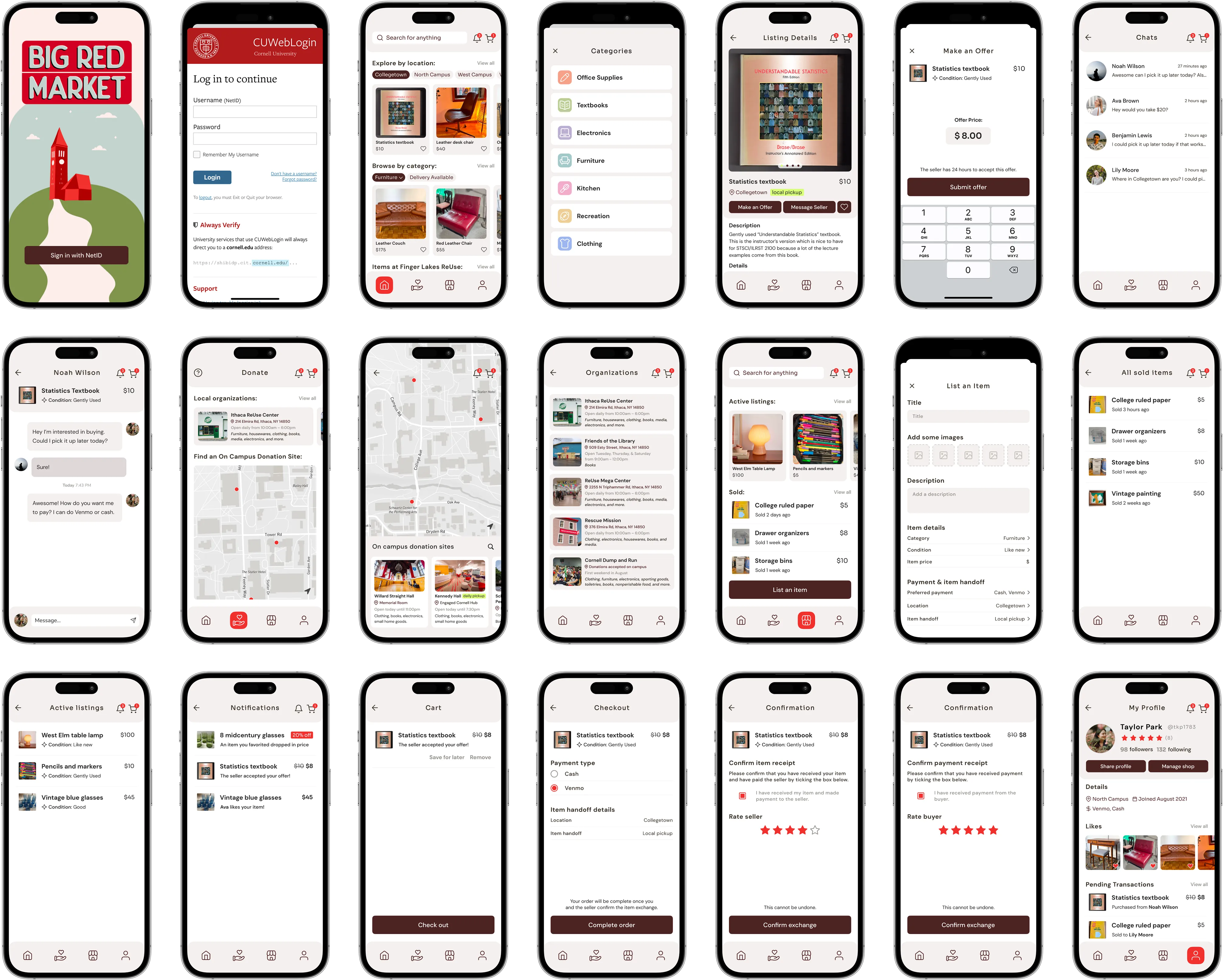
High Fidelity Prototype
We incorporated feedback gathered from participants during usability tests to refine our mockups and user flow, developing the following high-fidelity prototype for Big Red Market.
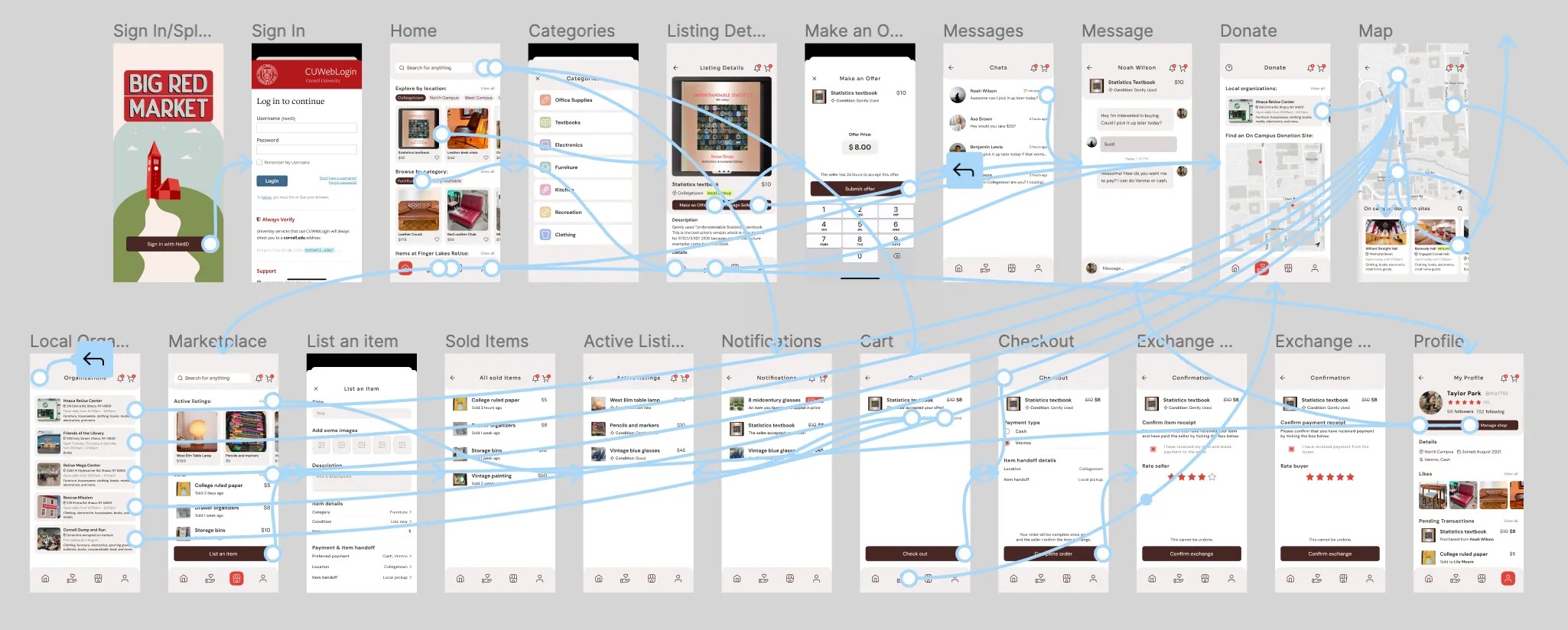
View the mockups and final high fidelity prototype in Figma: Figma High-Fidelity Prototype
Visual System
Typography
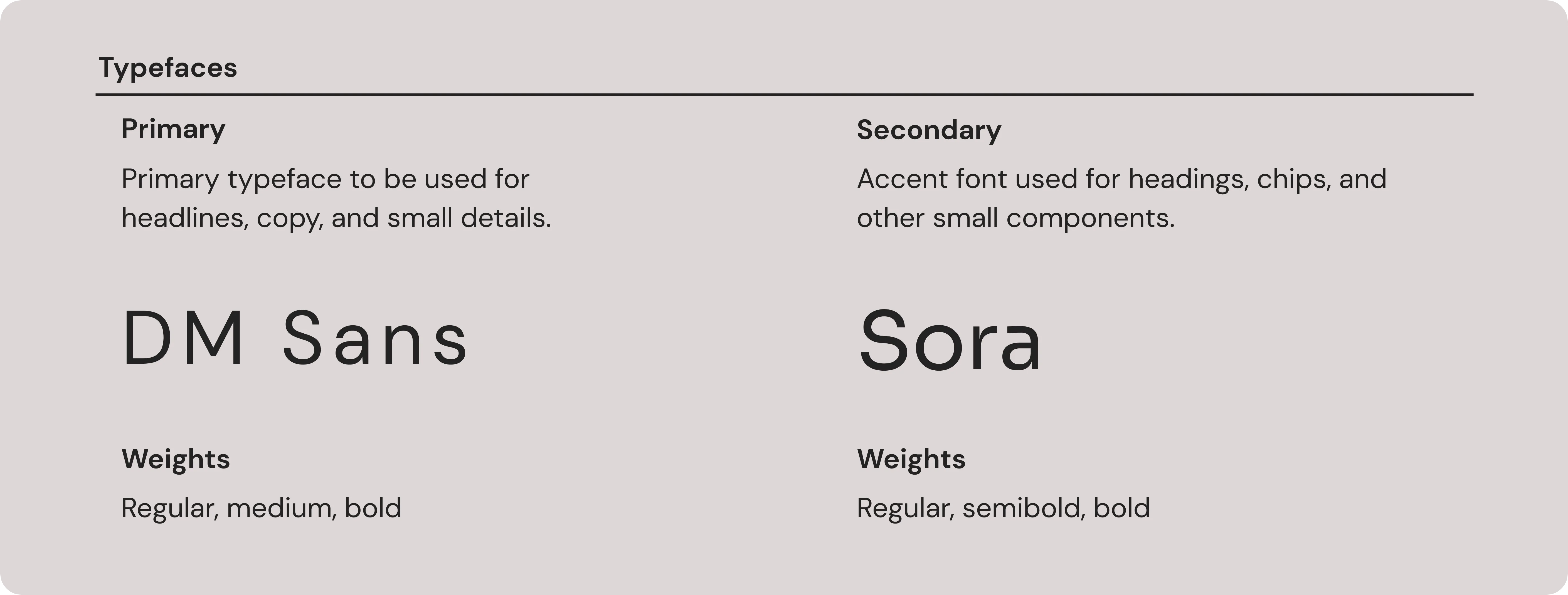
Color Palette
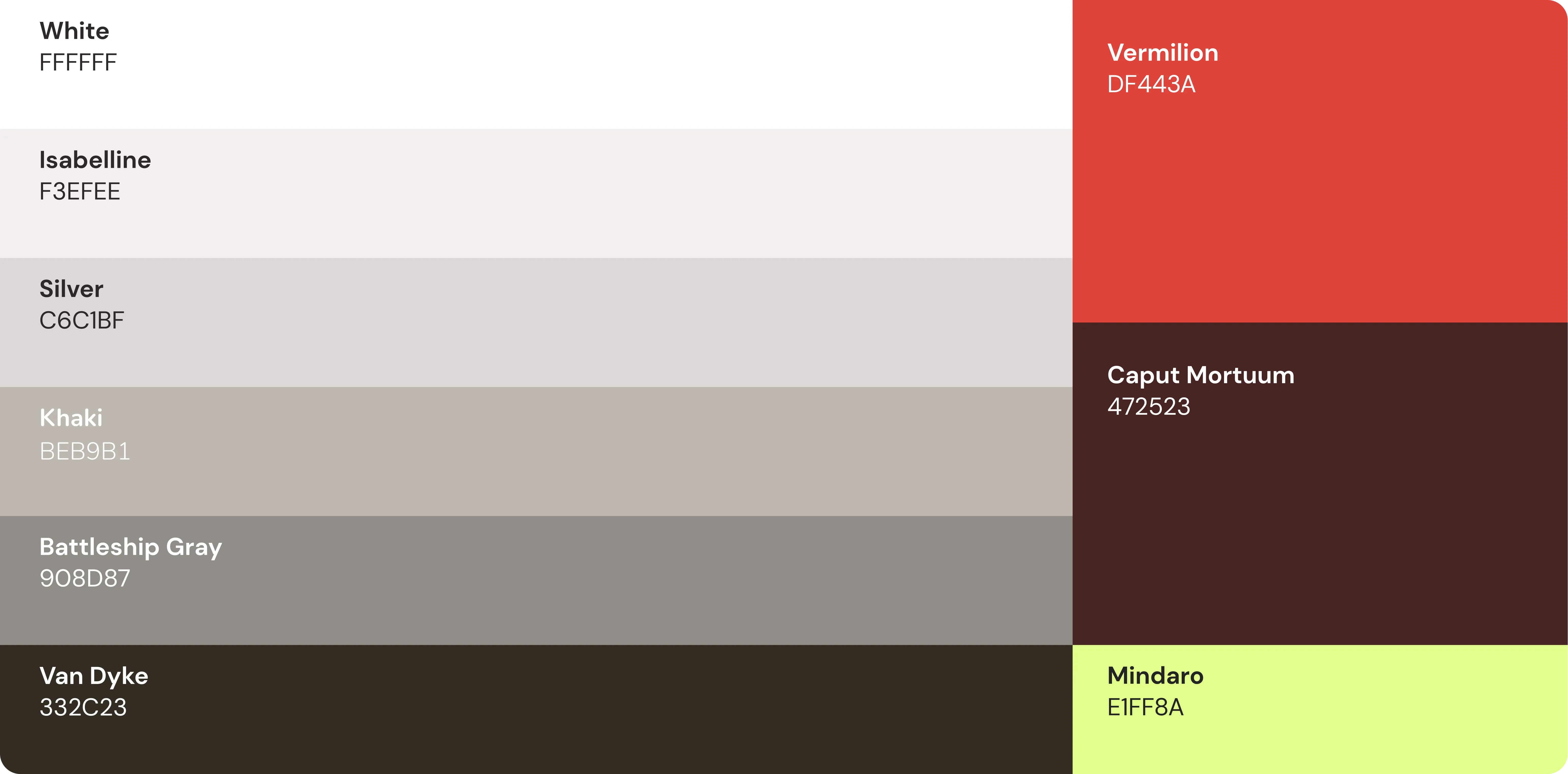
Components
I opted for a minimalist approach when designing the visual elements of the app. The choice to keep the components and icons clean and simple was driven by a desire to create a user interface that is both aesthetically pleasing and easy to navigate.
One key design decision was to give all the buttons an 8px corner radius, which not only imparts a modern and sleek look but also ensures a sense of approachability and friendliness. The rounded corners of the chips further enhance this friendly tone, making interactions with the app feel inviting and enjoyable.
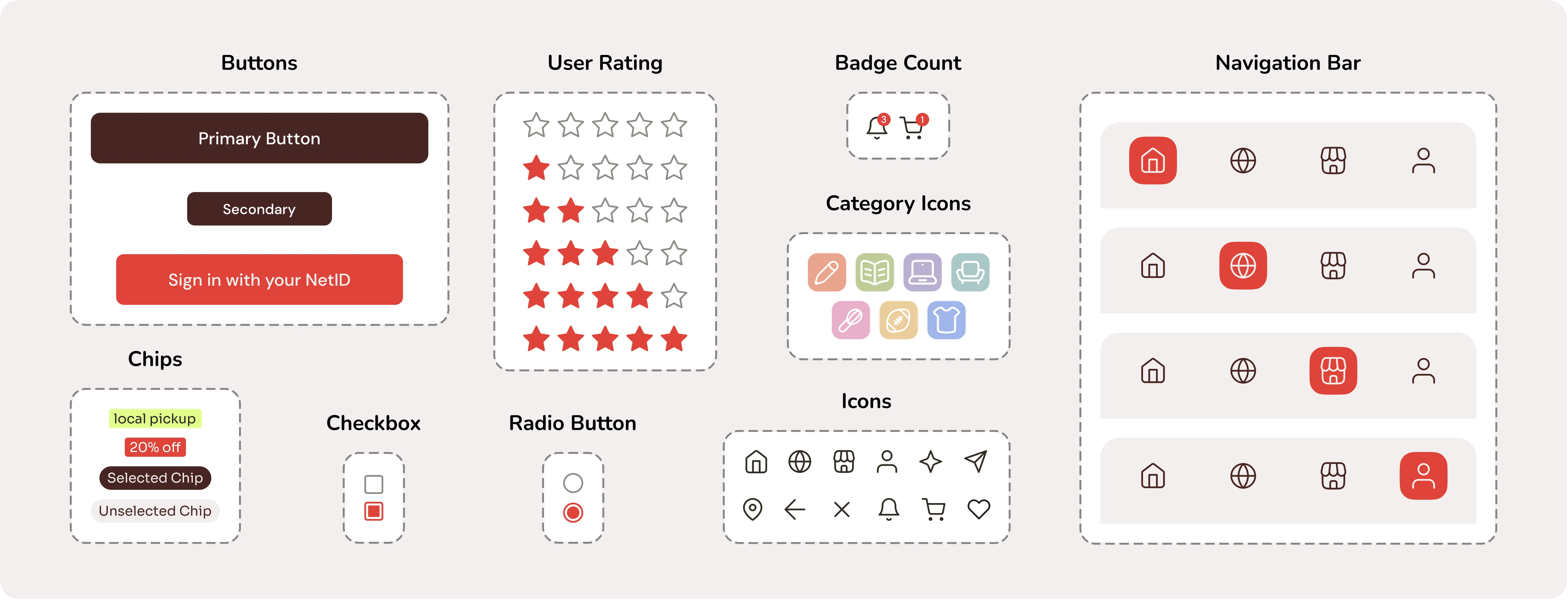
Takeaways
Expected Outcomes
We would like to see students and Cornell community members reduce their consumption of new goods, make an effort to donate and repurpose their gently used items, and reduce waste on campus overall.
What I Learned
During this project, I learned that regular testing and iteration are necessary for creating a product that actually serves its users – you should not try to guess what your users will need. Continuous evaluation at different stages allowed me and my team members to spot areas for improvement, leading to a more user-friendly app aligned with our intended users' preferences.
Working with a team with diverse skill sets emphasized the importance of leveraging everyone's strengths. Recognizing individual skills helped us allocate tasks efficiently and solve challenges collaboratively. This also expanded my own skill set and prompted me to explore new avenues of design thinking.
As this was my first formal UX design project working with a team, I gained experience in articulating and justifying my design decisions while collaborating within a team. As the lead designer, I had the responsibility of finding a balance between meeting the team's expectations and creating a solution that I could take pride in.